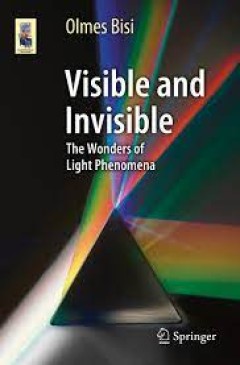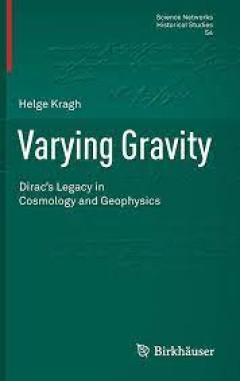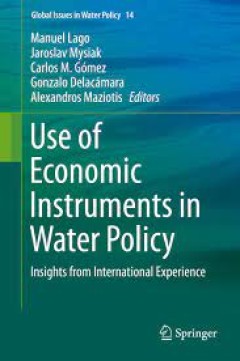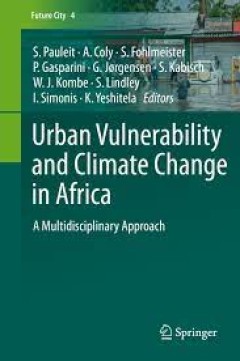Filter by

Visible and Invisible The Wonders of Light Phenomena
Light phenomena have intrigued humankind since prehistory. Think of the rainbow, a sunset on the sea, a game of shadows. Humans have always used light for their own needs, from cooking food to illuminating a room. However, light is not only limited to what we can see with our eyes. The invisible part of the electromagnetic spectrum is broad and dynamic. This book outlines the mysteries and w…
- Edition
- -
- ISBN/ISSN
- 978-3-319-09825-8
- Collation
- XXI, 314
- Series Title
- -
- Call Number
- -

Virgin Galactic The First Ten Years
Thirty years ago when Sir Richard Branson called up Boeing and asked if they had a spare 747, few would have predicted the brash entrepreneur would so radically transform the placid business of air travel. But today, Branson flies airlines on six continents, employs hundreds of jets and, in 2014, was predicting that his spaceship company – Virgin Galactic – would soon open the space frontie…
- Edition
- -
- ISBN/ISSN
- 978-3-319-09262-1
- Collation
- XIX, 203
- Series Title
- -
- Call Number
- -

Viewing and Imaging the Solar System A Guide for Amateur Astronomers
Viewing and Imaging the Solar System: A Guide for Amateur Astronomers is for those who want to develop their ability to observe and image Solar System objects, including the planets and moons, the Sun, and comets and asteroids. They might be beginners, or they may have already owned and used an astronomical telescope for a year or more. Newcomers are almost always wowed by sights such as the…
- Edition
- -
- ISBN/ISSN
- 978-1-4614-5179-2
- Collation
- XIII, 256
- Series Title
- -
- Call Number
- -

Varying Gravity Dirac’s Legacy in Cosmology and Geophysics
The main focus of this book is on the interconnection of two unorthodox scientific ideas, the varying-gravity hypothesis and the expanding-earth hypothesis. As such, it provides a fascinating insight into a nearly forgotten chapter in both the history of cosmology and the history of the earth sciences. The hypothesis that the force of gravity decreases over cosmic time was first proposed by …
- Edition
- -
- ISBN/ISSN
- 978-3-319-24379-5
- Collation
- 4 b/w illustrations, 12 illustrations in colour
- Series Title
- -
- Call Number
- -

Value Economics The Ethical Implications of Value for New Economic Thinking
The last financial crisis revealed a gap between business practice and ethics. In Value Economics, Griffiths and Lucas examine some of the reasons for this ethical gap and discuss the resulting loss of confidence in the financial system. One of the reasons has been hazy or inadequate thinking about how we value economic enterprises. With the close link between the creation of value and business…
- Edition
- -
- ISBN/ISSN
- 978-1-137-54187-1
- Collation
- XV, 281
- Series Title
- -
- Call Number
- -

Use of Economic Instruments in Water Policy Insights from International Expe…
This book assesses both the effectiveness and efficiency of implemented Economic Policy Instruments (EPIs) in order to achieve water policy goals and identifies the preconditions under which they outperform alternative (e.g. regulatory) policy instruments and/or can complement them as part of complex policy mixes. The development of a consolidated assessment framework helps clarify (and where p…
- Edition
- -
- ISBN/ISSN
- 978-3-319-18287-2
- Collation
- 4 b/w illustrations, 42 illustrations in colour
- Series Title
- -
- Call Number
- -

Agarwood: Science Behind the Fragrance
This book gives readers new information to understand the mechanism of agarwood induction and therefore eradicate the myths surrounding agarwood formation. One of the challenges in conserving agarwood resources is species identification. In this book, taxonomy and systematics of agarwood-producing trees from historical and recent perspectives is discussed, and tips are given for identifying cul…
- Edition
- Ed. 1
- ISBN/ISSN
- 978-981-10-0833-7
- Collation
- X, 167
- Series Title
- Tropical Forestry
- Call Number
- 615.4 AGA a

Urban Vulnerability and Climate Change in Africa A Multidisciplinary Approach
Urbanisation and climate change are among the major challenges for sustainable development in Africa. The overall aim of this book is to present innovative approaches to vulnerability analysis and for enhancing the resilience of African cities against climate change-induced risks. Locally adapted IPCC climate change scenarios, which also consider possible changes in urban population, have been …
- Edition
- -
- ISBN/ISSN
- 978-3-319-03982-4
- Collation
- 16 b/w illustrations, 115 illustrations in colour
- Series Title
- -
- Call Number
- -

Urban Development Challenges, Risks and Resilience in Asian Mega Cities
In this book, an interdisciplinary research group of faculty members, researchers, professionals, and planners contributed to an understanding of the dynamics and dimensions of emerging challenges and risks in megacities in the rapidly changing urban environments in Asia and examined emerging resilience themes from the point of view of sustainability and public policy. The world’s urban popul…
- Edition
- -
- ISBN/ISSN
- 978-4-431-55043-3
- Collation
- 66 b/w illustrations, 85 illustrations in colour
- Series Title
- -
- Call Number
- -

Unlocking the Secrets of White Dwarf Stars
White dwarfs, each containing about as much mass as our Sun but packed into a volume about the size of Earth, are the endpoints of evolution for most stars. Thousands of these faint objects have now been discovered, though only a century ago only three were known. They are among the most common stars in the Milky Way Galaxy, and they have become important tools in understanding the universe. Ye…
- Edition
- -
- ISBN/ISSN
- 978-3-319-09369-7
- Collation
- 34 b/w illustrations, 37 illustrations in colour
- Series Title
- -
- Call Number
- -
 Computer Science, Information & General Works
Computer Science, Information & General Works  Philosophy & Psychology
Philosophy & Psychology  Religion
Religion  Social Sciences
Social Sciences  Language
Language  Pure Science
Pure Science  Applied Sciences
Applied Sciences  Art & Recreation
Art & Recreation  Literature
Literature  History & Geography
History & Geography